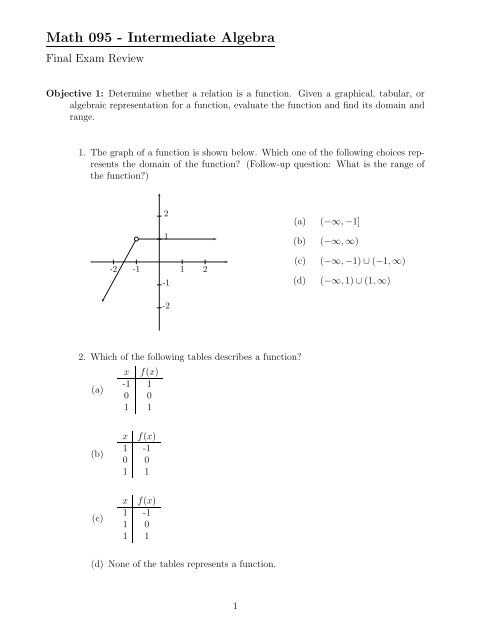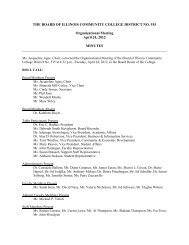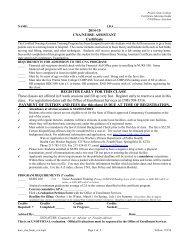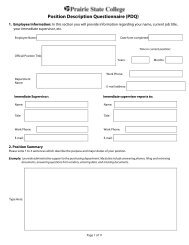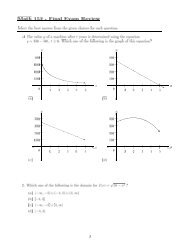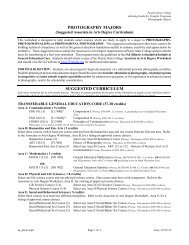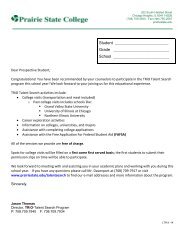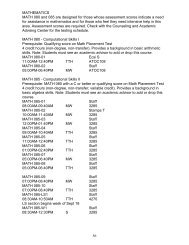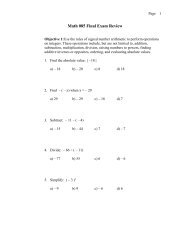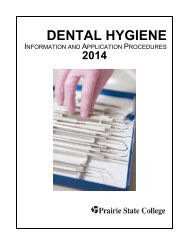Math 095 - Intermediate Algebra - Prairie State College
Math 095 - Intermediate Algebra - Prairie State College
Math 095 - Intermediate Algebra - Prairie State College
You also want an ePaper? Increase the reach of your titles
YUMPU automatically turns print PDFs into web optimized ePapers that Google loves.
<strong>Math</strong> <strong>095</strong> - <strong>Intermediate</strong> <strong>Algebra</strong><br />
Final Exam Review<br />
Objective 1: Determine whether a relation is a function. Given a graphical, tabular, or<br />
algebraic representation for a function, evaluate the function and find its domain and<br />
range.<br />
1. The graph of a function is shown below. Which one of the following choices represents<br />
the domain of the function (Follow-up question: What is the range of<br />
the function)<br />
2<br />
1<br />
-2 -1 1 2<br />
-1<br />
(a) (−∞, −1]<br />
(b) (−∞, ∞)<br />
(c) (−∞, −1) ∪ (−1, ∞)<br />
(d) (−∞, 1) ∪ (1, ∞)<br />
-2<br />
2. Which of the following tables describes a function<br />
(a)<br />
x f(x)<br />
-1 1<br />
0 0<br />
1 1<br />
(b)<br />
x f(x)<br />
1 -1<br />
0 0<br />
1 1<br />
(c)<br />
x f(x)<br />
1 -1<br />
1 0<br />
1 1<br />
(d) None of the tables represents a function.<br />
1
3. Given the function f(x) = x 2 + x + 2, which of the following represents f(−1)<br />
(a) −x 2 − x − 2<br />
(b) x 2 − x + 2<br />
(c) 2<br />
(d) 0<br />
Objective 2: Given the graph of a line, an equation of a line, or two points on a line, find<br />
the slope and y-intercept of the line.<br />
4. Find the slope and y-intercept of the line described by the equation 5x −2y = 10.<br />
(a) slope is 5/2, y-intercept is (0, −5)<br />
(b) slope is 5/2, y-intercept is (0, 5)<br />
(c) slope is −5/2, y-intercept is (0, −5)<br />
(d) slope is −5/2, y-intercept is (0, 5)<br />
5. A line passes through the points (2, 0) and (4, 4). Find the slope and y-intercept<br />
of the line.<br />
(a) slope is 2, y-intercept is (0, −4)<br />
(b) slope is 2, y-intercept is (2, 0)<br />
(c) slope is 1/2, y-intercept is (0, −4)<br />
(d) slope is −1/2, y-intercept is (−4, 0)<br />
6. Find the slope and y-intercept of the line shown below.<br />
y<br />
✻<br />
✕<br />
✲<br />
x<br />
☛<br />
(a) slope is −2, y-intercept is (0, 2)<br />
(b) slope is 2, y-intercept is (1, 0)<br />
(c) slope is 2, y-intercept is (0, −2)<br />
(d) slope is 1/2, y-intercept is (0, −2)<br />
2
Objective 3: Find equations of lines in slope-intercept or point-slope form. Find equations<br />
of horizontal or vertical lines. Determine whether lines are parallel, perpendicular, or<br />
neither.<br />
7. A line passes through the points (2, −2) and (4, 1). Find an equation of the line<br />
in slope-intercept form.<br />
(a) y − 1 = 3 (x − 4)<br />
2<br />
(b) y = 2 3 x − 4<br />
(c) y + 2 = 2 (x − 2)<br />
3<br />
(d) y = 3 2 x − 5<br />
8. Find an equation of the horizontal line passing through the point (−3, 8).<br />
(a) 8y − 3x = 0<br />
(b) y = 8<br />
(c) −3x = 8y<br />
(d) x = −3<br />
9. Two linear equations are given below. Which one of the following is true of the<br />
graphs of the equations<br />
y = 5x − 1<br />
x + 5y = 10<br />
(a) The graphs are parallel lines.<br />
(b) The graphs are perpendicular lines.<br />
(c) The graphs intersect at the point (0, −1).<br />
(d) The graphs are parabolas.<br />
Objective 4: Determine whether a system of two linear equations in two variables has no<br />
solution, exactly one solution, or infinitely many solutions. Solve systems of two linear<br />
equations in two variables by using substitution, elimination, or graphical methods.<br />
10. Solve the following system of linear equations. What is the y-coordinate of your<br />
solution<br />
y = 2x + 4<br />
(a) y = 4<br />
(b) y = 1<br />
(c) There are infinitely many solutions.<br />
(d) There is no solution.<br />
6x − 3y = 1<br />
3
11. Solve the following system of linear equations. What is the x-coordinate of your<br />
solution<br />
6x + 3y = 12<br />
(a) x = 6<br />
(b) x = 4<br />
(c) There are infinitely many solutions.<br />
(d) There is no solution.<br />
y = −2x + 4<br />
12. Solve the following system of linear equations. What is the y-coordinate of your<br />
solution<br />
2x + y = 4<br />
(a) y = 1<br />
(b) y = 2<br />
(c) There are infinitely many solutions.<br />
(d) There is no solution.<br />
3x + 2y = 7<br />
Objective 5: Solve application problems that require setting up and solving a system of<br />
two linear equations in two variables.<br />
13. A parking meter contains only nickels and dimes worth $6.05. If there are eightynine<br />
coins in all, what is the value of the nickels alone<br />
(a) $57.00<br />
(b) $3.25<br />
(c) $5.55<br />
(d) $2.85<br />
14. A chemist has two concentrations of hydrochloric acid in stock: a 50% solution<br />
and an 80% solution. How much of each should she mix to obtain 100 milliliters<br />
of a 68% solution<br />
(a) 40 milliliters of 50% solution and 60 milliliters of 80% solution<br />
(b) 60 milliliters of 50% solution and 40 milliliters of 80% solution<br />
(c) 68 milliliters of 50% solution and 32 milliliters of 80% solution<br />
(d) 32 milliliters of 50% solution and 68 milliliters of 80% solution<br />
4
Objective 6: Find unions and intersections of intervals. Sketch the graph of an interval.<br />
Convert between interval notation and inequality notation.<br />
15. Find the union and the intersection of the intervals (−∞, 6] and (−3, ∞).<br />
(a) union: (−3, 6), intersection: (−∞, ∞)<br />
(b) union: (−∞, ∞), intersection: (−3, 6]<br />
(c) union: (−∞, −3), intersection: [6, ∞)<br />
(d) union: (−∞, ∞), intersection: (−3, 6)<br />
16. Which one of the following intervals is described by the inequality −2 ≤ x < 17<br />
(a) (−2, 17]<br />
(b) (−∞, −2] ∪ (17, ∞)<br />
(c) [−2, 17)<br />
(d) (−∞, −2] ∩ (17, ∞)<br />
17. Sketch the graph of the interval described by the inequality 5 < x ≤ 12.<br />
(a) ✛ ❢ ✈<br />
5 12<br />
(b) ✛ ✈ ❢<br />
5 12<br />
(c) ✛ ✈ ✈<br />
5 12<br />
(d) ✛ ❢ ❢<br />
5 12<br />
✲<br />
✲<br />
✲<br />
✲<br />
Objective 7: Solve compound linear inequalities in one variable. Solve application problems<br />
that require setting up and solving linear inequalities in one variable.<br />
18. Solve the following compound inequality. Write your solution in interval notation.<br />
(a) (−2, 1]<br />
(b) (−1, 2]<br />
(c) There is no solution.<br />
(d) All real numbers are solutions.<br />
−11 < 5x − 1 ≤ 4<br />
5
19. Solve the following compound inequality. Write your solution in interval notation.<br />
(a) (−∞, −1) ∪ [14, ∞)<br />
(b) (−1, 14]<br />
(c) (−2, 4]<br />
(d) (−∞, −2) ∪ [4, ∞)<br />
2x + 1 < −3 or x + 5 ≥ 9<br />
20. Tess has $30 and she wants to go to the fair. It costs $10 for admission and $1.50<br />
per ride. How many rides can she afford<br />
(a) 11 rides<br />
(b) 20 rides<br />
(c) 13 rides<br />
(d) 14 rides<br />
Objective 8: Solve linear absolute-value equations.<br />
21. Solve for p: |2p − 4| = 6<br />
(a) p = 1<br />
(b) p = 5 or p = −1<br />
(c) p = −5 or p = 1<br />
(d) p = 5 or p = 1<br />
22. Solve for z:<br />
3z + 5<br />
∣ 6 ∣ − 3 = 6<br />
(a) z = − 40<br />
3 or z = −41 3<br />
(b) z = − 39<br />
3 or z = 39 3<br />
(c) z = 4 or z = 5<br />
(d) z = − 59<br />
3 or z = 49 3<br />
6
23. Solve for m:<br />
∣ ∣∣∣ ∣ −3 4 m + 8 + 7 = 5<br />
(a) There is no solution.<br />
(b) All real numbers are solutions.<br />
(c) m = 8 or m = 40/3<br />
(d) m = 40/3<br />
Objective 9: Solve linear absolute-value inequalities. Graph solutions on the number line,<br />
write solutions as inequalities, write solutions in interval notation, and write solutions<br />
in set-builder notation.<br />
24. Solve the following inequality: 7 + |5x − 3| ≥ 6<br />
(a) x > 2/5<br />
(b) x < −2 or x > 2<br />
(c) There is no solution.<br />
(d) All real numbers are solutions.<br />
25. Solve the following inequality. Graph your solution on a number line.<br />
1 − |x + 3| > −6<br />
(a) ✛ ❢ ❢<br />
−10 4<br />
(b) ✛ ❢ ❢<br />
−8 2<br />
(c) ✛ ❢ ❢<br />
−1 6<br />
(d) ✛ ❢ ❢<br />
−6 1<br />
✲<br />
✲<br />
✲<br />
✲<br />
26. Solve the following inequality. Write your solution in interval notation.<br />
(a) (−6, 2/3)<br />
(b) (−∞, −6) ∪ (2/3, ∞)<br />
(c) There is no solution.<br />
(d) All real numbers are solutions.<br />
|3x + 8| > 10<br />
7
Objective 10: Solve inequalities and systems of inequalities in two variables. Sketch the<br />
graphs of the solution sets.<br />
27. Which one of the graphs shown below illustrates the solution set of the following<br />
system of inequalities<br />
6x + 2y < 4<br />
y + 3 ≥ 2x<br />
(a)<br />
y<br />
(b)<br />
y<br />
8<br />
8<br />
6<br />
6<br />
4<br />
4<br />
2<br />
-8 -6 -4 -2 2 4 6 8<br />
-2<br />
x<br />
2<br />
-8 -6 -4 -2 2 4 6 8<br />
-2<br />
x<br />
-4<br />
-4<br />
-6<br />
-6<br />
-8<br />
-8<br />
(c)<br />
y<br />
(d)<br />
y<br />
8<br />
8<br />
6<br />
6<br />
4<br />
4<br />
2<br />
-8 -6 -4 -2 2 4 6 8<br />
-2<br />
x<br />
2<br />
-8 -6 -4 -2 2 4 6 8<br />
-2<br />
x<br />
-4<br />
-4<br />
-6<br />
-6<br />
-8<br />
-8<br />
8
28. Which one of the graphs shown below illustrates the solution set of the following<br />
system of inequalities<br />
x ≥ 0<br />
y ≥ 0<br />
x ≤ 7<br />
(a)<br />
y<br />
(b)<br />
y<br />
8<br />
8<br />
6<br />
6<br />
4<br />
4<br />
2<br />
-8 -6 -4 -2 2 4 6 8<br />
-2<br />
x<br />
2<br />
-8 -6 -4 -2 2 4 6 8<br />
-2<br />
x<br />
-4<br />
-4<br />
-6<br />
-6<br />
-8<br />
-8<br />
(c)<br />
y<br />
(d)<br />
y<br />
8<br />
8<br />
6<br />
6<br />
4<br />
4<br />
2<br />
-8 -6 -4 -2 2 4 6 8<br />
-2<br />
x<br />
2<br />
-8 -6 -4 -2 2 4 6 8<br />
-2<br />
x<br />
-4<br />
-4<br />
-6<br />
-6<br />
-8<br />
-8<br />
9
Objective 11: Convert expressions involving rational exponents to radical expressions and<br />
vice versa.<br />
29. Rewrite with rational exponents: ( 5√ xy 2 ) 15<br />
(a) (xy 2 ) 3/5<br />
(b) (x 5 y 2 ) 1/3<br />
(c) (xy 2 ) 5<br />
(d) (xy 2 ) 3<br />
30. Rewrite in radical form: (9x 3 y 2 ) 7/4<br />
7<br />
(a) √ 9xy 4<br />
4<br />
(b) √ 9x 3 y 2<br />
(c) ( 4√ 9x 3 y 2 ) 7<br />
(d) ( 7√ 9x 3 y 2 ) 4<br />
Objective 12: Simplify radical expressions where the radicand is a monomial.<br />
31. Assuming x and y represent positive numbers, simplify the following expression.<br />
√<br />
4x2 y 6<br />
(a) 2xy 3<br />
(b) 16x 4 y 12<br />
(c) 2x 2 y 6<br />
(d) 2x 4 y 3<br />
32. Simplify:<br />
3√<br />
5a8 b 6 c 4<br />
(a) 5a 2 b 2 c 3√ a 2 c 4<br />
(b) a 2 b 2 c 3√ 5a 2 c 4<br />
(c) a 2 b 2 c 3√ 5a 2 c<br />
(d) 5a 2 b 2 c 3√ a 2 c<br />
10
Objective 13: Add, subtract, and multiply radical expressions. Simplify the results. [The<br />
expressions may consist of sums or differences of radicals. Only monomial radicands<br />
are considered.]<br />
33. Expand and simplify the following expression.<br />
(a) − √ x<br />
(b) x − 1<br />
(c) x − √ x − 6<br />
(d) 2 √ x − 1<br />
(2 + √ x)( √ x − 3)<br />
34. Expand and simplify the following expression.<br />
(a) x + 9<br />
(b) x + 3<br />
(c) 6 + 2 √ x<br />
(d) x + 6 √ x + 9<br />
( √ x + 3) 2<br />
35. Simplify and combine like radicals.<br />
3√<br />
x3 + 3√ x 3 y 2 + x 3√ y 2<br />
(a) 3x + 2 3√ y 2<br />
(b) x + 2x 3√ y 2<br />
(c) 3x 3√ y 2<br />
(d) x + 3√ xy 2 + x 3√ y 2<br />
36. Simplify and combine like radicals.<br />
3√<br />
27 +<br />
3 √ 81 − 4 3√ 3<br />
(a) 3 − 3√ 3<br />
(b) −2 3√ 111<br />
(c) 2 3√ 3<br />
(d) −2 3√ 3<br />
11
Objective 14: Divide radical expressions and rationalize denominators. [Only monomial<br />
radicands are considered.]<br />
37. Rationalize the denominator and simplify:<br />
2n<br />
√<br />
18n<br />
(a) 1 9<br />
(b)<br />
(c)<br />
√<br />
2n<br />
3<br />
n<br />
√<br />
3<br />
(d)<br />
√<br />
3n<br />
2n<br />
38. Rationalize the denominator and simplify:<br />
(a) 2 + √ x<br />
4 − √ x<br />
2<br />
2 − √ x<br />
(b) 4 + 2√ x<br />
4 − x<br />
(c) 1 + 2√ x<br />
1 − x<br />
(d) 4 + 2√ x<br />
4 − √ x<br />
Objective 15: Solve radical equations where the radicand is a linear expression.<br />
39. Solve for x:<br />
√ 3x + 4 = −2<br />
(a) x = 0<br />
(b) x = −8/3<br />
(c) x = 8/3<br />
(d) There is no real solution.<br />
40. Solve for y: 6 − 2 √ 3y = −10<br />
(a) y = 64/3<br />
(b) y = 8/3<br />
(c) y = 16/3<br />
(d) There is no real solution.<br />
12
Objective 16: Simplify complex numbers and write in standard form a + bi. [Students<br />
must be prepared to add, subtract, multiply, and divide complex numbers, as well as<br />
write square roots of negative numbers in complex form.]<br />
41. Expand and simplify. Write your result in standard form.<br />
(a) 7i 2 + 2i − 2<br />
(b) 12i 2 + 2i − 2<br />
(c) −14 + 2i<br />
(d) −7 + 2i<br />
(2 + 4i)(3i − 1)<br />
42. Expand and simplify. Write your result as a complex number in standard form.<br />
√<br />
−9(<br />
√<br />
−9 + 1)<br />
(a) −9 + 3i<br />
(b) 9 + 3i<br />
(c) 9 + √ −9<br />
(d) 10<br />
43. Simplify and write in standard form:<br />
(a) −3/2<br />
(b) i<br />
(c) 5i<br />
(d) 2i2 + 5i + 2<br />
−i 2 + 4<br />
1 + 2i<br />
2 − i<br />
Objective 17: Solve all types of quadratic equations, including those with complex solutions.<br />
Solve rational equations that reduce to quadratic equations.<br />
x 2<br />
44. Solve for x:<br />
3 = −2 3 x − 5 3<br />
(a) x = 1 + i or x = 1 − i<br />
(b) x = −1 + 2i or x = −1 − 2i<br />
(c) x = −2 + i or x = −2 − i<br />
(d) x = 4 + 2i or x = 4 − 2i<br />
13
45. Solve for y: 2y 2 + 5y − 3 = 0<br />
(a) y = −2 or y = 1/2<br />
(b) y = −3 or y = 2<br />
(c) y = −1 or y = 1/2<br />
(d) y = −3 or y = 1/2<br />
46. Solve for x, and then find the sum of the two solutions.<br />
(a) 2<br />
(b) 2 √ 3<br />
(c) 2 + √ 3<br />
(d) 0<br />
x − 2 = 2 x<br />
Objective 18: Solve application problems that require setting up and solving quadratic<br />
equations. [Students should be prepared to use simple geometric formulas such as<br />
those giving the areas of rectangles and triangles.]<br />
47. The product of two consecutive numbers is 56. If x is the greater of the two<br />
numbers, then which quadratic equation represents the problem situation<br />
(a) x(x + 1) = 56<br />
(b) x(x − 1) = 56<br />
(c) x + (x − 1) = 56<br />
(d) x + (x + 1) = 56<br />
48. The length of a room is 2ft less than twice its width. The area of the room is<br />
60ft 2 . Find the length of the room.<br />
(a) The length is 6ft.<br />
(b) The length is 10ft.<br />
(c) The length is 4ft.<br />
(d) The length is 15ft.<br />
49. A garden is twice as long as it is wide. The square of its perimeter is 4356ft 2 .<br />
Find the width of the garden.<br />
(a) The width is 8ft.<br />
(b) The width is 16ft.<br />
(c) The width is 22ft.<br />
(d) The width is 11ft.<br />
14
Objective 19: Graph quadratic functions. Find vertices and x- and y-intercepts of parabolas.<br />
50. The function f is written below in two different, but equivalent, forms:<br />
f(x) = 2(x − 2) 2 + 3 f(x) = 2x 2 − 8x + 11<br />
Using either one of the forms for f, sketch the graph of f.<br />
(a)<br />
y<br />
(b)<br />
y<br />
8<br />
8<br />
6<br />
6<br />
4<br />
4<br />
2<br />
-8 -6 -4 -2 2 4 6 8<br />
-2<br />
x<br />
2<br />
-8 -6 -4 -2 2 4 6 8<br />
-2<br />
x<br />
-4<br />
-4<br />
-6<br />
-6<br />
-8<br />
-8<br />
(c)<br />
y<br />
(d)<br />
y<br />
8<br />
8<br />
6<br />
6<br />
4<br />
4<br />
2<br />
-8 -6 -4 -2 2 4 6 8<br />
-2<br />
x<br />
2<br />
-8 -6 -4 -2 2 4 6 8<br />
-2<br />
x<br />
-4<br />
-4<br />
-6<br />
-6<br />
-8<br />
-8<br />
51. Which of the following is an equation for a parabola that opens up and has vertex<br />
(−4, 5) (Each equation is written in two different, but equivalent, forms.)<br />
(a) y = (x − 4) 2 + 5 or y = x 2 − 8x + 21<br />
(b) y = (x + 4) 2 + 5 or y = x 2 + 8x + 21<br />
(c) y = −(x + 4) 2 − 5 or y = −x 2 − 8x − 21<br />
(d) y = −(x − 4) 2 − 5 or y = −x 2 + 8x − 21<br />
15
52. Which quadratic function shown below has the given graph (Each function is<br />
written in two different, but equivalent, forms.)<br />
y<br />
8<br />
6<br />
4<br />
2<br />
-8 -6 -4 -2 2 4 6 8<br />
-2<br />
-4<br />
-6<br />
-8<br />
x<br />
(a) f(x) = −2(x − 3) 2 + 2 or f(x) = −2x 2 + 12x − 16<br />
(b) f(x) = −(x + 3) 2 + 2 or f(x) = −x 2 − 6x − 7<br />
(c) f(x) = (x − 3) 2 − 2 or f(x) = x 2 − 6x + 7<br />
(d) None of the above<br />
Objective 20: Solve application problems involving the Pythagorean theorem.<br />
53. The triangle shown below has the given dimensions, some of which depend on<br />
the unknown quantity x. Use the Pythagorean theorem to set up and solve an<br />
equation for x.<br />
√<br />
17<br />
✘✘ ✘✘✘ ✘ ✘✘✘ ✘ ✘✘<br />
x<br />
(a) x = −4<br />
(b) x = 1<br />
(c) x = 7<br />
(d) x = 4.86119<br />
x + 3<br />
54. The length of one leg of a right triangle is two inches more than twice the length<br />
of the other leg. Find the perimeter of the triangle if the hypotenuse measures 13<br />
inches.<br />
(a) 33in<br />
(b) 32in<br />
(c) 31in<br />
(d) 30in<br />
16
Objective 21: Solve application problems involving direct and inverse variation.<br />
55. When a car travels at a constant speed, the distance it travels varies directly as<br />
the time of travel. If a car travels 87 miles in 2 hours, then how many miles does<br />
it travel in 7 hours<br />
(a) 609mi<br />
(b) 304.5mi<br />
(c) 407.3mi<br />
(d) 24.86mi<br />
56. The quantities x and y vary inversely so that x = 10 when y = 8. Find x when<br />
y = 40.<br />
(a) x = 50<br />
(b) x = 100<br />
(c) x = 5<br />
(d) x = 2<br />
Objective 22: Use substitution to solve polynomial equations that reduce to quadratic<br />
equations.<br />
57. Solve for x, and then find the sum of the two solutions.<br />
(a) 4<br />
(b) 1<br />
(c) 8<br />
(d) 3/16<br />
4(2x + 1) 2 − 16(2x + 1) + 15 = 0<br />
58. In order to solve for x, which is the most appropriate substitution<br />
(a) let u = x 6<br />
(b) let u = 2x 3<br />
(c) let u = 3√ x<br />
(d) let u = x 3 17<br />
x 6 + 2x 3 = 8
Free Response Problems: On your final exam you must show all work to receive full<br />
credit for the free response problems.<br />
59. A medieval alchemist’s love potion calls for a number of eyes of newt and toes<br />
of frog, the total being 21, but with twice as many newt eyes as frog toes. How<br />
many of each are required Set up a system of linear equations that corresponds<br />
to the problem situation and use any method to solve the system.<br />
60. Graph the parabola given by the equation y = x 2 + 4x + 3. Find the coordinates<br />
of the vertex and the x-intercepts.<br />
✻<br />
✲<br />
18
61. Solve for x:<br />
√ x + 3 = 2x.<br />
62. Simplify:<br />
5 √ 64x 8 y 15<br />
63. Solve for x: |7 − 2x| − 7 = 15 + x<br />
64. Solve and write your solution in interval notation.<br />
2 < −8x + 4 ≤ 36<br />
65. Determine the domain of the function f.<br />
f(x) =<br />
5<br />
√ x − 2<br />
19
Answer Key<br />
1. c, Follow-up: Range is (−∞, 1] 21. b 41. c<br />
2. a 22. d 42. a<br />
3. c 23. a 43. b<br />
4. a 24. d 44. b<br />
5. a 25. a 45. d<br />
6. c 26. b 46. a<br />
7. d 27. a 47. b<br />
8. b 28. a 48. b<br />
9. b 29. d 49. d<br />
10. d 30. c 50. d<br />
11. c 31. a 51. b<br />
12. b 32. c 52. a<br />
13. d 33. c 53. b<br />
14. a 34. d 54. d<br />
15. b 35. b 55. b<br />
16. c 36. a 56. d<br />
17. a 37. b 57. b<br />
18. a 38. b 58. d<br />
19. d 39. d<br />
20. c 40. a<br />
For problems 59–65, see your instructor for help and evaluation of your work.<br />
<strong>Prairie</strong> <strong>State</strong> <strong>College</strong>, Department of <strong>Math</strong>ematics<br />
May 8, 2007<br />
http://math.prairiestate.edu<br />
10 9 8 7 6 5 4 3<br />
20


